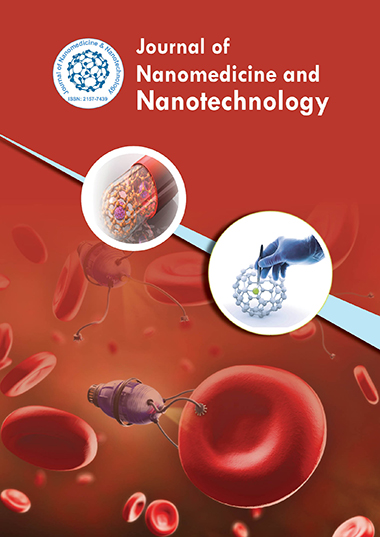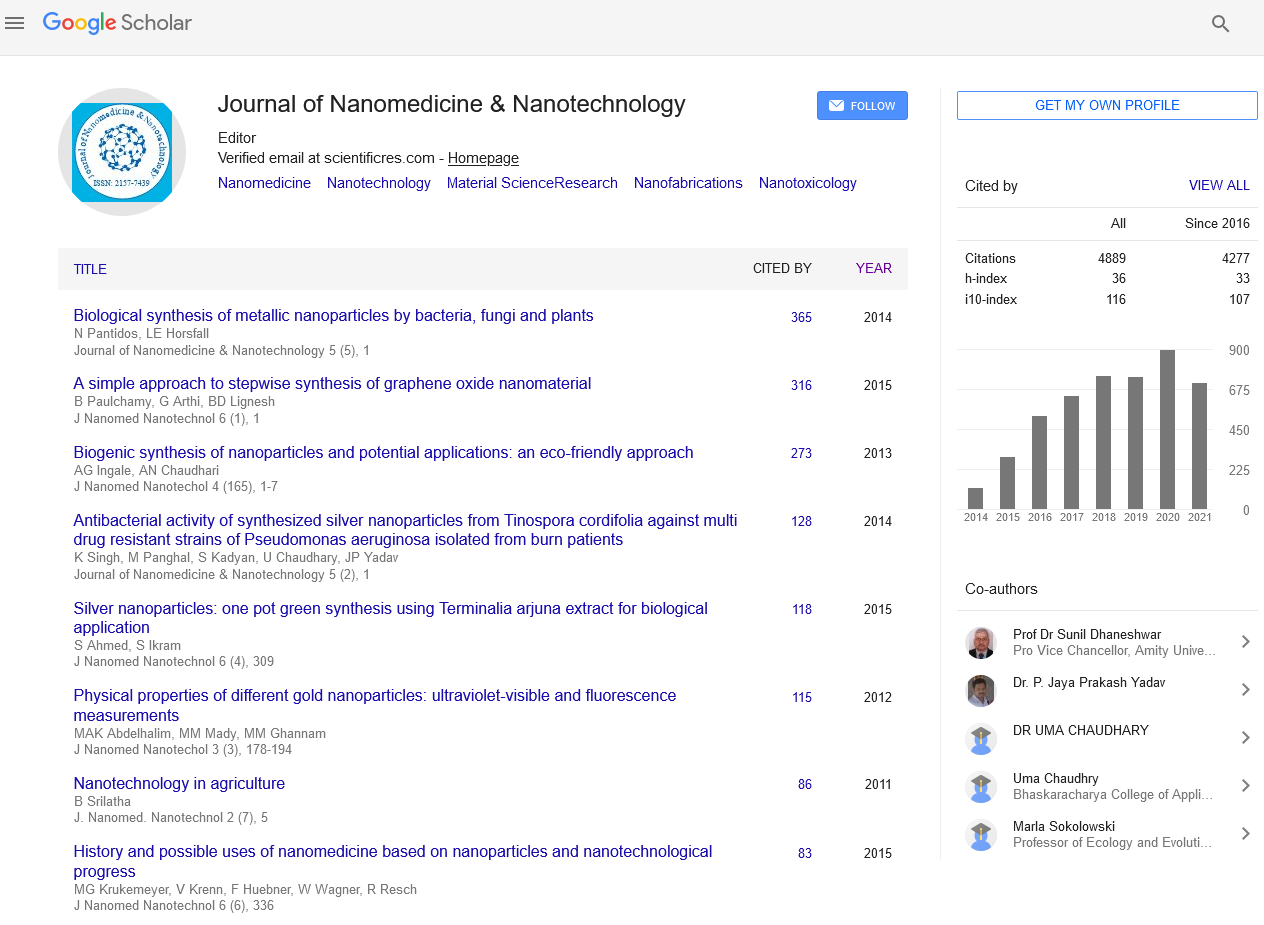Indexed In
- Open J Gate
- Genamics JournalSeek
- Academic Keys
- JournalTOCs
- ResearchBible
- China National Knowledge Infrastructure (CNKI)
- Scimago
- Ulrich's Periodicals Directory
- Electronic Journals Library
- RefSeek
- Hamdard University
- EBSCO A-Z
- OCLC- WorldCat
- SWB online catalog
- Virtual Library of Biology (vifabio)
- Publons
- MIAR
- Scientific Indexing Services (SIS)
- Euro Pub
- Google Scholar
Useful Links
Share This Page
Journal Flyer

Open Access Journals
- Agri and Aquaculture
- Biochemistry
- Bioinformatics & Systems Biology
- Business & Management
- Chemistry
- Clinical Sciences
- Engineering
- Food & Nutrition
- General Science
- Genetics & Molecular Biology
- Immunology & Microbiology
- Medical Sciences
- Neuroscience & Psychology
- Nursing & Health Care
- Pharmaceutical Sciences
Editorial - (2024) Volume 15, Issue 5
Nanoparticle-Mediated Drug Delivery Systems Advancements and Applications
Ayumu Hoshino*Received: 03-Sep-2024, Manuscript No. jnmnt-24-27231; Editor assigned: 05-Sep-2024, Pre QC No. jnmnt-24-27231 (PQ); Reviewed: 20-Sep-2024, QC No. jnmnt-24-27231; Revised: 24-Sep-2024, Manuscript No. jnmnt-24-27231 (R); Published: 30-Sep-2024, DOI: 10.35248/2157-7439.24.15.754
Abstract
Nanoparticle-mediated drug delivery systems (NDDS) have emerged as a revolutionary approach in the field of medicine, particularly in targeted therapy and controlled release applications. This article reviews recent advancements in NDDS, focusing on various types of nanoparticles, their fabrication methods, mechanisms of drug loading and release, and their applications in treating cancer, cardiovascular diseases, and infectious diseases. The potential of NDDS to improve drug solubility, stability, and bioavailability is also discussed, alongside the challenges and future perspectives in the field.
Keywords
Nanoparticle; Drug Delivery; Targeted Therapy; Cancer Treatment; Biocompatibility
INTRODUCTION
The advent of nanotechnology has transformed drug delivery systems by enabling the design of nanoparticles that can encapsulate therapeutic agents, enhancing their efficacy and minimizing side effects. Conventional drug delivery methods often face limitations such as poor solubility, rapid clearance from the body, and non-specific distribution. Nanoparticle-mediated drug delivery systems (NDDS) address these challenges by facilitating targeted delivery and controlled release, thus improving therapeutic outcomes [1].
TYPES OF NANOPARTICLES
Liposomes
Liposomes are spherical vesicles composed of lipid bilayers that can encapsulate both hydrophilic and hydrophobic drugs. Their biocompatibility and ability to form stable formulations make them ideal for drug delivery. Liposomal formulations, such as Doxil® (liposomal doxorubicin), have shown enhanced circulation time and reduced toxicity, leading to improved therapeutic indices in cancer treatment [2].
Dendrimers
Dendrimers are branched macromolecules with a well-defined structure. Their unique architecture allows for multiple functional groups on their surface, enabling drug loading and targeting. Dendrimers can deliver anticancer agents and imaging agents, enhancing the effectiveness of chemotherapy and diagnostic imaging.
Polymeric Nanoparticles
Polymeric nanoparticles, made from biodegradable polymers like PLGA (poly(lactic-co-glycolic acid)), offer advantages in controlled release and biodegradability. These nanoparticles can be engineered to release drugs in response to specific stimuli (e.g., pH or temperature), making them suitable for targeted cancer therapy.
Metallic Nanoparticles
Metallic nanoparticles, such as gold and silver nanoparticles, have unique optical and electronic properties. They can be used for drug delivery, photothermal therapy, and imaging applications [3]. Their ability to enhance drug solubility and stability makes them a promising platform in nanomedicine.
MECHANISMS OF DRUG LOADING AND RELEASE
Drug Loading
The efficiency of drug loading in NDDS is critical for therapeutic efficacy. Methods for loading drugs into nanoparticles include passive loading, solvent evaporation, and coacervation techniques. For instance, in liposomes, drugs can be encapsulated during the formation of the lipid bilayer, while dendrimers can load drugs via non-covalent interactions or covalent bonding.
Drug Release
Controlled release of drugs from nanoparticles can be achieved through various mechanisms, such as diffusion, degradation, or external stimuli. Stimuli-responsive nanoparticles can release drugs in response to specific environmental triggers, such as pH changes in tumor tissues or temperature variations. This targeted release enhances therapeutic effects while minimizing side effects [4].
Applications in Medicine
Cancer Treatment
NDDS have shown significant promise in cancer therapy by improving the selectivity and efficacy of chemotherapeutic agents. By encapsulating drugs within nanoparticles, it is possible to achieve higher concentrations of drugs at tumor sites while reducing systemic toxicity. For example, polymeric nanoparticles loaded with paclitaxel have demonstrated enhanced antitumor activity and reduced side effects in preclinical models.
Cardiovascular Diseases
In cardiovascular therapy, NDDS can facilitate the targeted delivery of anti-inflammatory drugs and gene therapies. Lipid-based nanoparticles have been used to deliver siRNA targeting genes involved in atherosclerosis, showing potential in reducing plaque formation and improving vascular health [5].
Infectious Diseases
Nanoparticles can enhance the efficacy of antiviral and antibacterial agents. For example, silver nanoparticles exhibit antimicrobial properties and can be used in formulations to treat infections. Furthermore, lipid-based nanoparticles are being investigated for delivering mRNA vaccines, showcasing their role in combating infectious diseases such as COVID-19 [6].
ADVANTAGES OF NANOPARTICLE-MEDIATED DRUG DELIVERY
Enhanced Solubility and Stability: NDDS can improve the solubility of poorly water-soluble drugs, enhancing their bioavailability and therapeutic efficacy.
Targeted Delivery: Functionalization of nanoparticles with targeting ligands (e.g., antibodies, peptides) allows for selective delivery to specific tissues or cells, reducing off-target effects.
Controlled Release: NDDS can provide sustained or controlled release of drugs, maintaining therapeutic levels over extended periods and minimizing dosing frequency [7].
Improved Pharmacokinetics: Nanoparticles can alter the pharmacokinetics of drugs, prolonging circulation time and enhancing tissue accumulation.
CHALLENGES AND LIMITATIONS
Despite their potential, NDDS face several challenges
Biocompatibility and Toxicity: The long-term effects of nanoparticles in the body are still not fully understood. Ensuring biocompatibility and minimizing toxicity remain critical concerns.
Scalability and Manufacturing: The production of nanoparticles at a commercial scale poses challenges related to consistency, quality control, and regulatory approval [8].
Stability: Maintaining the stability of nanoparticle formulations during storage and administration is essential for ensuring therapeutic efficacy.
Regulatory Hurdles: The approval process for nanoparticle-based therapies can be complex, requiring extensive preclinical and clinical testing to demonstrate safety and efficacy [9].
FUTURE PERSPECTIVES
The future of NDDS holds great promise, with ongoing research aimed at overcoming current challenges. Innovations in nanoparticle design, such as the development of hybrid nanoparticles and personalized nanomedicine, are expected to enhance the specificity and efficacy of drug delivery systems. Furthermore, integrating advanced imaging techniques with NDDS may provide real-time monitoring of drug distribution and therapeutic response [10].
CONCLUSION
Nanoparticle-mediated drug delivery systems represent a transformative approach in modern medicine, offering numerous advantages over traditional drug delivery methods. By enhancing drug solubility, stability, and targeting, NDDS have the potential to significantly improve therapeutic outcomes in various diseases, particularly cancer. However, addressing the challenges related to biocompatibility, scalability, and regulatory compliance is essential for the successful translation of these systems into clinical practice.
REFERENCES
- Li y, Jiang Y, Huang K. Ding P, Chen J. Preparation and properties of magnetic Fe3O4–chitosan nanoparticles. Journal of alloys and compounds.2008; 466(1-2): 451-456.
- Poole C P, Owens F J. Introduction to nanotechnology. 2003.
- Fulekar M. Nanotechnology: importance and applications. IK International Pvt Ltd. 2010.
- Villegas R, Ramírez L, Guevara H, Sicairos P, Ayala H, Sanchez L. Synthesis and characterization of magnetite nanoparticles for photocatalysis of nitrobenzene. Journal of Saudi Chemical Society.2020;24(2): 223-235.
- Newbury E, Ritchie W. Is scanning electron microscopy/energy dispersive X‐ray spectrometry (SEM/EDS) quantitative? Scanning. 2013; 35(3):141-168.
- Pan Z, Lin Y, Sarkar B, Owens G, Chen Z. Green synthesis of iron nanoparticles using red peanut skin extract: Synthesis mechanism, characterization and effect of conditions on chromium removal. Journal of Colloid and Interface Science.2020; 558: 106-114.
- Qu S, Huang F, Yu S, Chen G, Kong J. Magnetic removal of dyes from aqueous solution using multi-walled carbon nanotubes filled with Fe2O3 particles. Journal of Hazardous Materials.2008; 160(2-3): 643-647.
- KaradeV, Waifalkar P, Dongle T, Sahoo S C, Kollu P, Patil P et al. Greener synthesis of magnetite nanoparticles using green tea extract and their magnetic properties. Mater Res Express.2017; 4(9): 096102.
- Almomani F, Bhosale R, Khraisheh M, Almomani T. Heavy metal ions removal from industrial wastewater using magnetic nanoparticles (MNP). Appl Surf Sci.2020; 506: 144924.
- Zulfiqar N. Effect of adding surfactant additives (sodium lauryl sulphate) in water on the performance of flat plate solar distillation system for the purification of water. 2023.
Indexed at, Google Scholar, Crossref
Indexed at, Google Scholar, Crossref
Indexed at, Google Scholar, Crossref
Indexed at, Google Scholar, Crossref
Indexed at, Google Scholar, Crossref
Indexed at, Google Scholar, Crossref
Indexed at, Google Scholar, Crossref
Indexed at, Google Scholar, Crossref
Citation: Ayumu H (2024) Nanoparticle-Mediated Drug Delivery Systems Advancements and Applications. J Nanomed Nanotech. 15: 754.
Copyright: ©2024 Ayumu H. This is an open-access article distributed under the terms of the Creative Commons Attribution License, which permits unrestricted use, distribution, and reproduction in any medium, provided the original author and source are credited.
Competing interests: The authors have declared that no competing interests exist.


